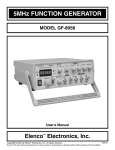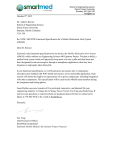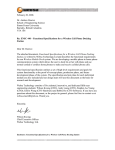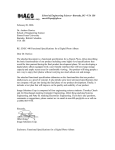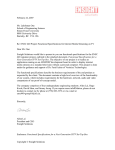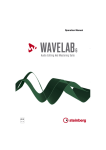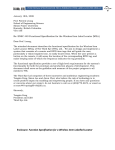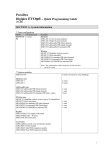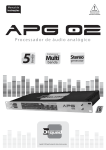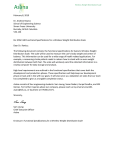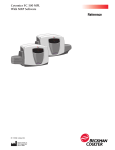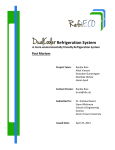Download License Plate Recognition (LPR) Auto-gate System
Transcript
February 16th, 2009 Mr. Patrick Leung School of Engineering Science Simon Fraser University 8888 University Drive Burnaby BC V5A 1S6 Re: ENSC440 Functional Specification for a License Plate Recognition Auto-gate System Dear Mr. Leung: The attached document, Functional Specification for a License Plate Recognition (LPR) Auto-gate System, outlines the system behavior of our project for ENSC 440 (Capstone Engineering Science Project). Our goal is to design and implement an auto-gate system for residential parking lots, using the LPR technology which captures a license plate image of a vehicle and verifies its registration status by post digital image processing for the parking lot access control. The purpose of the document is to provide functional specifications of our system regarding several necessary functional requirements for its implementation and design, including general, physical, electrical, safety, LPR software requirements and others. Further research, design and development will refer to this document as a strong guideline for the final product. Seco Innovations Corporation consists of three talented 5th Engineering students: Danny Choi, Wook Sun Shim, and Jaehoon Shin. Gathering various knowledge and strength from our disciplines in Electronics and Systems options and from industrial co-op work experiences, we are here to challenge on the project that can replace the current solution by providing better security and convenience to the public. If you have any questions regarding our proposal, please feel free to contact me by phone at 604-996-6012 or by e-mail at [email protected]. Sincerely, Danny Choi President and CEO Seco Innovations Corporation Enclosure: Functional Specification for a License Plate Recognition (LPR) Autogate System Functional Specification License Plate Recognition (LPR) Auto-gate System Project Team: Danny Chol Wook Sun Shim Jaehoon Shin Contact Person: Danny Choi [email protected] Submitted to: Patrick Leung – ENSC 440 Steve Whitmore – ENSC 305 School of Engineering Science Simon Fraser University Issued Date: February 16th, 2009 Revision: 2.2 i Copyright © 2009, Seco Innovations Corporation Executive Summary In these days, a lot of high rise buildings or apartments are constructed due to increase in population with limited land size. These buildings require huge parking lots that are usually built at underground. However, the auto theft crime has become critical as the unattended parking areas could be a great draw for thieves. To protect the parking lots from any theft crime, auto gated system is installed with remote transmitter used as entry key, but still thieves succeed at trespassing the gate from any possible flaws of the system. The LPR auto gate system is designed to protect thieves from entering the underground parking lots. Once the gate is open, there will be still no physical barrier to crime prevention, but the system will be activated if any unregistered vehicle or person tries to trespass the gate and sound an alarm immediately. Also, using the LPR system would eliminate the use of any entry keys, which results in more convenience for users of the parking lot. The development of the LPR auto gate system would be planned for two phases. The first phase contains the following features: The approaching vehicle triggers the camera activation. The vehicle license plate number is recognized via digital image processing. The gate opens for access when the recognition is verified The above would be the basic and primary function of our system and will be completed in the mid-March of 2009. Then, the second phase of the system development would play a key role in the security and planned for completion in April 2009. The features are The camera detects any approaching vehicle whilst the gate is open. The license plate number recognition is implemented for verification of the following vehicle after an entry. The gate closes if the vehicle is unregistered. Alarm sounds immediately if the vehicle attempts to enter the gate. Camera captures and save the trespassing scene. Thus, the access to the parking area is limited not only by the gate which works as a physical barrier, but also by the security alarm and surveillance camera which act as a virtual barrier. By adding the second line of defence, the LPR auto-gate system provides better security and hence, provides a peace of mind to users and managements. Seco innovations will design the system so that the gate will automatically open based on the verification and stay open so long as it detects any object or person at the line of gate. By following the functional specification provided in the later sections of this document, the system is expected to provide safer solutions to above mentioned flaws than current auto-gate systems do, as well as better security and convenience. ii Copyright © 2009, Seco Innovations Corporation Table of Contents Executive Summary .........................................................................................................ii List of Figures ..................................................................................................................iv Glossary ..........................................................................................................................iv 1. Introduction ................................................................................................................. 1 1.1. Scope .............................................................................................................................. 1 1.2. Intended Audience........................................................................................................... 1 1.3. Classification ................................................................................................................... 1 2. System Requirements ................................................................................................. 2 2.1. System Overview............................................................................................................. 2 2.2. General Requirements..................................................................................................... 3 2.3. Physical Requirements .................................................................................................... 3 2.4. Electrical Requirements ................................................................................................... 3 2.5. License Plate Recognition (LPR) Algorithm Requirements .............................................. 4 2.6. Environmental Requirements........................................................................................... 4 2.7. Safety and Security Requirements................................................................................... 4 2.8. Performance Requirements ............................................................................................. 5 2.9. Usability Requirements .................................................................................................... 5 2.10. Reliability and Durability Requirements.......................................................................... 6 2.11. Standards and Regulations Requirements..................................................................... 6 2.12. User Documentation Requirement ................................................................................. 7 3. System Test Plan ........................................................................................................ 8 3.1. Unit Test .......................................................................................................................... 8 3.2. Integration Test................................................................................................................ 9 3.3. Event Simulation.............................................................................................................. 9 4. Conclusion ................................................................................................................ 10 5. References ................................................................................................................ 11 iii Copyright © 2009, Seco Innovations Corporation List of Figures Figure 1: Proof-of-Concept System Flowchart ................................................................ 2 Glossary LCD LED LPR RF RoHS WEEE Liquid Crystal Display Light Emitting Diode License Plate Recognition Radio Frequency Restriction of Hazardous Substances Waste Electrical and Electronic Equipment iv Copyright © 2009, Seco Innovations Corporation 1. Introduction The License Plate Recognition (LPR) Auto-gate System is an innovative solution to the motor-vehicle theft that provides more secure and convenient parking environments. The system recognises license plate from the approaching vehicle, and digitally verifies whether the vehicle is permitted to enter premises. By keeping trespassers and potential thieves from entering the property, both car owners and building managements can benefit from the system. The functional requirements for the system, proposed by Seco Innovations, will be described in this document in detail. 1.1. Scope The functional specification for the system defines the requirements and the system standards which need to be met by the LPR auto-gate system. The list of functional requirements will drive the design of the proof-of-concept system, as well as final product in the future as the system is to be commercialized. Thus, the document will provide a guideline for the system design decisions later on. 1.2. Intended Audience The functional specification outlines the requirements of LPR auto-gate system which will provide better security for multi-residential building parking lots. This document is intended for use by all individuals of Seco Innovations Corporation to ensure valid quality and performance of the system. Each team member shall refer to the functional requirements to keep the product development in the right path towards a common goal. Furthermore, it provides a general idea of how the system operates to building managers and residents. 1.3. Classification The following notations will be used to denote functional requirements throughout the functional specification of the system: [Rn-p] A functional requirement where R is the abbreviation for requirement, n is the functional requirements number, p is the priority of the functional requirements as denoted by following lists: I. II. III. The functional requirement for the proof-of-concept system only. The functional requirement for both the proof-of-concept system and final commercialised product. The functional requirement for final commercialised product only. 1 Copyright © 2009, Seco Innovations Corporation 2. System Requirements The general overview of the system and functional requirements of the LPR auto-gate system are listed in this section of the document. 2.1. System Overview LPR auto-gate system can be divided into many smaller parts: input metal detector, camera module, digital image processing module and output system. The figure below illustrates the high-level proof-of-concept system flowchart and how the components interact with each other. Figure 1: Proof-of-Concept System Flowchart 1 When an approaching vehicle is detected by metal detector, it activates camera module and an image of the front side of vehicle will be captured. Digital image processing module will localise the license plate of the vehicle and perform character recognition from it. Then the system will digitally convert the characters to ASCII characters and display the license plate number on the LCD board. The system output will turn on LED with green or red to indicate verification status. If the system detects any trespasser either by car or foot while the parking lot entrance gate is open the alarm will sound to notify the security personal on site and captures the scene for enforcement purpose. Due to the limitation on budget and time, the proof-of-concept system will exclude some features of final commercialised system. While other operation stays unchanged, the final product shall interact with the entrance gate. User interface unit to manage the database of the registered vehicle shall also be included in the final product design. Furthermore, intranet or internet-based interface shall be implemented in the final design to enable visitor vehicle registration by the residents. The logic of the system is carefully designed and analysed to provide good sense of security, and at the same time, to minimize misbehaviour of sounding alarm when it is not necessary. The alarm sounds immediately only if an unregistered vehicle or a person tries to pass the entrance gate line. 1 The figure is created by using Microsoft Word 2007 SmartArt. 2 Copyright © 2009, Seco Innovations Corporation 2.2. General Requirements [R1-II] The distance between the camera site and the metal detector not be too close or too far in order to obtain reasonable image resolution. [R2-III] The license plate site shall be provided with additional light source to capture a better quality image during night time. [R3-II] A sensor shall be at the line of the gate to detect trespassing. [R4-II] The integrated system shall be priced under $800. [R5-III] The system shall verify vehicles entering the parking lot as well as vehicles exiting the parking lot, for enhanced security. [R6-III] The camera module shall be water-proof or at least have the protection to such weather condition. 2.3. Physical Requirements [R7-II] The camera shall not be installed at most 1.5 m above the ground to clearly capture the license plate in adequate angle, as most vehicles have their license plate mounted closer to the level of ground. [R8-III] The camera mount shall be able to be rotated around ±45° horizontally for initial installation. [R9-III] The camera mount shall be able to be rotated around ±45° vertically for initial installation. [R10-III] The camera, computer and the database shall be covered with hard cases with a lock system to provide physical limit in its access or possible damage. 2.4. Electrical Requirements [R11-I] The power supply for the microcontroller board shall be sufficient for microcontroller, alarm sound, and LED module. [R12-II] The power supply adapter shall be compatible with the standard North American 110V/120V, 60Hz wall outlet. [R13-II] The camera shall be powered by the computer through the USB cable. 3 Copyright © 2009, Seco Innovations Corporation [R14-II] The computer shall not be powered off; instead, it shall be in sleep mode when it is not used to save power consumption. [R15-III] The camera module shall be powered by the power supply from the auto gate, if it is directly installed onto the gate. [R16-III] The desktop and the database shall have the back-up power source in case of the power failure. 2.5. License Plate Recognition (LPR) Algorithm Requirements [R17-II] The license plate number shall be converted to ASCII characters accurately at least in 95% success rate. [R18-II] The localization of the license plate shall be made correctly without confusion with other similar objects in figure. [R19-III] The digital image processing shall be completed within one second to minimize the waiting time of the vehicle operators and hence to provide greater convenience. [R20-III] The recognized license plate number shall be searched in database and valid verification must be provided to grant an access. 2.6. Environmental Requirements [R21-II] The LPR system shall work properly in all weather conditions such as rain, snow, fog and also in night time. [R22-II] On-board system shall be enclosed and resistant to moistures or water. [R23-II] On-board system shall operate properly regardless of the four seasons. In addition, it shall operate properly in the temperature range of -20°C to 50°C. [R24-III] The camera lens shall be enclosed so to be clear in sight for all weather and environmental conditions. 2.7. Safety and Security Requirements [R25-II] The gate shall not close when any person or vehicle is detected at the line of the gate. [R26-II] The priority of the access shall be granted as first come first served. 4 Copyright © 2009, Seco Innovations Corporation [R27-II] The alarm shall sound immediately at the moment of the trespassing attempt. [R28-II] Any approaching vehicle, whilst the gate is open or closed, shall be detected for LPR verification. [R29-III] Any person enters through the opened gate shall be detected as trespassing. [R30-III] The gate shall have a separate entry door for residents’ access by foot to prevent false alarm. 2.8. Performance Requirements [R31-II] The camera shall be activated and capture the image of an approached vehicle to the gate immediately upon detection. [R32-II] The LPR system shall perform digital image processing for verification immediately after camera module captures an image. [R33-II] The alarm sound shall be loud enough for adequate notification to security personal on site for better security performance. [R34-II] The character recognition shall be completed within one second after the image of the license plate is captured. [R35-III] The camera shall remain activated while the gate is open to verify any following entry attempt. [R36-III] The vehicle detector shall be located at a close distance to the camera to capture the license plate clearly. 2.9. Usability Requirements [R37-II] All software user interfaces shall be written in English. [R38-II] LPR algorithm software shall be user-friendly, intuitive, and easy-to-learn by building management. [R39-II] The verification status shall be clearly displayed to the vehicle operator on LCD panel and LED. [R40-II] The alarm shall clearly notify security personal on site, should any trespassing attempt is detected. 5 Copyright © 2009, Seco Innovations Corporation [R41-III] Database for registered vehicle shall be upgradable by building management. [R42-III] Database management user interface shall be user-friendly, intuitive and easy-to-learn. [R43-III] The brief instructions and warning signs regarding the system operations shall be clearly displayed at the parking area for resident education purposes. 2.10. Reliability and Durability Requirements [R44-II] All components shall be serviceable by trained technicians. [R45-II] All components shall be resistant to damages caused by the weather conditions, such as rain or snow. [R46-II] Overall system shall be checked and serviced at least annually for its accuracy and performance. [R47-II] Camera module shall be in operational condition as long as it is not turned off manually or its power source is not disconnected from the module. [R48-II] Main server or personal computer running image processing module shall be on at all times so long as its power source is not disconnected or the machine does not fail due to an unpredictable malfunction. 2.11. Standards and Regulations Requirements [R49-II] All components shall be built with environmentally friendly components that satisfy Restriction of Hazardous Substances (RoHS) Directive. [1] [R50-II] All components shall conform to Waste Electrical and Electronic Equipment (WEEE) Directive. [1] [R51-III] The parking lot gate shall conform to UL-325 Regulation and employ a noncontact safety device to prevent injuries or death due to the closing gate. [2] [R52-III] All electrical parts of the system shall clearly display warning signs to prevent electrical hazard to the users and technicians. [R53-III] All mechanical parts of the system shall clearly display warnings regarding potential hazard associated with the system operation. 6 Copyright © 2009, Seco Innovations Corporation 2.12. User Documentation Requirement [R54-I] All user documentation shall be written in English. [R55-III] User documentation shall include a website with general and technical information of the system, a user’s manual for end-point users, and installation guide for vendors and technicians. [R56-III] Installation guide for the engineers and technicians shall provide clear and comprehensive hardware and software installation procedure. [R57-III] All user documentation shall be written for the audience with minimal technical knowledge of the system. [R58-III] If the product is to be commercialised internationally, all user documentation shall be translated into the languages commonly used in the country. 7 Copyright © 2009, Seco Innovations Corporation 3. System Test Plan To achieve its goal and obtain strong confidence in the final product, Seco Innovations has planned highly comprehensive and efficient test methods in all different stages throughout the development cycle. At each stage, both software and hardware designs will be tested concurrently to ensure the functionality specified in the document. More technical details regarding the test plans will be discussed in the future design specifications document. The test plan is divided into three stages: unit test, integration test, and event simulation. Since the three stages are correlated, every requirement must be tested and verified on each stage before proceeding to the next stage. 3.1. Unit Test The proof-of-concept system can be divided into two sub-units; the microcontroller board with a metal detector, and the License Plate Recognition system. Each sub-unit has different functionalities and requirements to be tested. The successful fulfilment on every requirement from each sub-unit will eliminate potential errors that are component related upon system integration. The metal detector for sensing an approaching vehicle will be tested with several different types and sizes of metal to enhance its accuracy of detection. By collecting voltage levels from the testing, a reference threshold will be set to distinguish a vehicle from other metallic objects. The microcontroller board acts as a bridge between the LPR software and the metal detector. Not only does it control sending and receiving signal to both sites, but it also outputs the pass or fail verdict via LED light and sounds an alarm in case of a trespassing. The test on this unit will mainly focus on embedded software to ensure an error-free control algorithm and accurate communication with LPR software. The test plan will also verify whether the microcontroller control algorithm can process the voltage signal from the metal detector and activate the camera module on main computer immediately. The output module on the microcontroller board, which includes LED, LCD panel and an alarm, will be tested by sending random sequence of passing and failing verification data to ensure an error-free operation. The license plate recognition system acts as the brain of the system, and therefore it is probably the most important part among the system components. To ensure high accuracy and performances, the LPR system will be tested numerous times using different standard British Columbia license plates. Also, since the different types of vehicles will approach to the gate possibly in various angles, the test plan will ensure that the system can recognise a skewed or slightly-rotated image of the license plate. The LPR system will also be tested practically under different environmental conditions; 8 Copyright © 2009, Seco Innovations Corporation for example, dark area using a light source, and bad weather conditions, such as rain, fog, or snow. 3.2. Integration Test After all of the individual modules have satisfied their own requirements, the integration test will be conducted to ensure the performance and the functionality of the overall system. To simply state, the integration test will mainly focus on testing the virtual connection between the PC with camera module and the microcontroller board with metal detector. The test will also monitor the valid information transfer between the modules. By fulfilling integration test requirement, all of the system parts will speak the same language upon integration. 3.3. Event Simulation Once the integration test is successfully completed, event simulation test will be implemented to verify that the system can function accurately and properly in practical circumstances. To simplify the test plan, the event simulation will be conducted in an open space, which can act as a replicated parking lot. Different types of vehicles will approach the metal detector in various speeds, to see if the system operates accurately regardless of the type and the speed of the vehicle. In addition, the environmental requirements will be tested again as event simulation, under different conditions, such as rainy or foggy weather. Along with the performance and accuracy of the system, robustness and durability of the external enclosure and internal components are equally important, since the product is usually located outdoor and is used on a daily basis. Stress test and accelerated life test will be conducted to ensure the durability of the product. Doing so will cover the issues that arise from realistic situations and hence eventually enhance the quality and reliability of the product. 9 Copyright © 2009, Seco Innovations Corporation 4. Conclusion This functional specification document clearly outlines capabilities, functions, requirements and standards for the LPR auto-gate system. By using the specifications as guideline, Seco Innovations will provide more secure and convenient parking environment which everyone can benefit from. The proof-of-concept system is well in progress of development and it is expected to be completed and meet all functional requirements defined by the target date of April 15 th, 2009. In addition, the final product will be completed in one year from the prototype production date, should the system is to be commercialized. 10 Copyright © 2009, Seco Innovations Corporation 5. References [1] Agile Business Consultants, EU RoHS Directive Compliance Solutions. 2008. http://www.pb-free.info/index.htm [Accessed: Feb 9th, 2009] [2] Underwriters Laboratories. UL-325: Door, Drapery, Gate, Louver, and Window Operators and Safety. 2009. http://www.ul.com/info/standard.htm [Accessed: Feb 10th, 2009] 11 Copyright © 2009, Seco Innovations Corporation
















